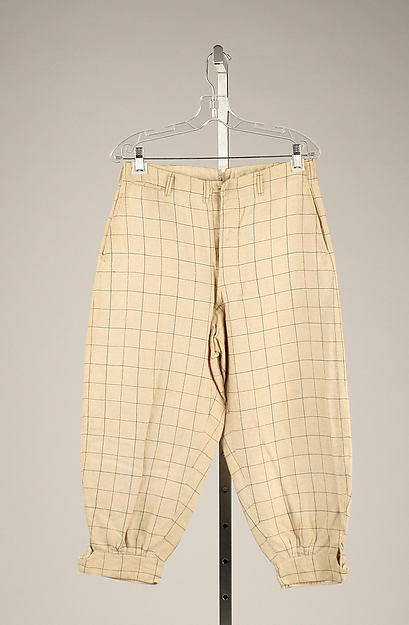Knickerbockers or “knickers” are full or baggy trousers gathered at the knee or just below and usually fastened with either a button or buckle. Knickerbockers were initially worn by men in the late 19th century and gradually became part of women’s fashion. The garment was usually worn as sportswear and became especially popular among golfers and female cyclists, hence the term “pedal pushers”.
The Details
T he Berg Dictionary of Fashion History defines knickerbockers as:
“A loose form of breeches of tweed, etc., fastening with a band below the knee; introduced at first for the voluntary militia, and then used by civilians for country pursuits; “cut three inches wider in the leg and two inches longer than ordinary breeches” (1871, The Tailor & Cutter). Usually worn with a Norfolk or other type of sports jacket for golf, etc. The name derived from the fictional Dutch founders of New York as depicted by Washington Irving in his History of New York by Dietrick Knickerbocker (1808).”
Alex Newman defines knickerbockers in Fashion A-Z: An Illustrated Dictionary (2009) as:
“Full, loose fitting pants that reach to the knee or just below, where they are gathered into a band and may be fastened with a buckle or button. First worn by men and boys in the mid 19th c., later became popular for woman also, especially for cycling and other sporting activities. So named because the American author Irving Washington (1783-1859) wrote A History Of New York (1809) under pseudonym knickerbocker, a name that came to be used in reference to New York’s original Dutch immigrants and, later, the baggy breeches which they wore.” (103)
Fig. 1 - Designer unknown (American). Black knickerbockers, ca. 1900. Cotton. New York: The Metropolitan Museum of Art, 1983.44.4. The Jacqueline Loewe Fowler Costume Collection, Gift of Jacqueline Loewe Fowler, 1983. Source: The Met
Fig. 2 - Designer unknown (American). Patterned Knickerbockers, first quarter 20th century. Wool. New York: The Metropolitan Museum of Art, 1981.149.13a, b. The Jacqueline Loewe Fowler Costume Collection, Gift of Jacqueline Loewe Fowler, 1981. Source: The Met
Fig. 3 - Designer unknown. Woman cyclist in knickerbockers, 1896. Photograph. Private Collection. Christchurch City Libraries. Source: Te Ara: The Encyclopedia of New Zealand
Fig. 4 - Designer unknown. Men's knickerbockers, 1997. Photograph. Men’s Fashion in the twentieth century. From frock coats to intelligent fibres, by Maria Costantino, 1997. Source: Wordpress
Fig. 5 - Artist unknown (American). Check printed knickerbockers, ca. 1900. Linen. New York: The Metropolitan Museum of Art, 1980.171.4. The Jacqueline Loewe Fowler Costume Collection, Gift of Jacqueline Loewe Fowler, 1980. Source: The Met
In Fairchild’s Dictionary of Fashion, Charlotte Mankey Calasibeta defines knickerbockers as:
“1. Loose breeches gathered or pleated into buckle band at knee, introduced for men about 1860 originally for country wear. 2. Worn by women for bicycling in early 1890s. 3. Used by men for golf and sportswear in late 19th c., and early 20th c. 4. Fashionable for boys from 1863 and worn with short collarless jacket, older boys wore with a waistcoat. By 1890s worn with Norfolk jacket. In early 20th c., usually called “knickers”.” (319)
The Encyclopedia of New Zealand writes of a late 19th-century photograph of a woman bicycling in knickerbockers (Fig. 3):
“Some 19th-century women wore ‘bloomers’ or knickerbockers for cycling – like this woman in Christchurch in 1896. But this attire sometimes attracted abuse from onlookers, as members of the city’s Atalanta Cycle Club found. They decided to revert to skirts in 1893, but later relaxed the rule as people got more accustomed to seeing women in trousers on bikes.”
The c. 1900 knickerbockers (Fig. 1) are baggy and more loose fitting; the gatherings under the knees are created with elastic instead of buttons or buckles. The knickerbockers in Figure 2 are a more tailored and modern version of the garment and were likely worn as a fashion piece and not for engaging in strenuous sport or activity. Indeed by the early 20th century, knickerbockers were not just worn as sportswear. As seen in Figure 3, the style became fashionable as regular menswear and was worn on a daily basis.
Fig. 6 - Designer unknown (American). Cremeknickerbockers, early 20th century. Wool. New York: The Metropolitan Museum of Art, 1979.152.29. Gift of Jessie Leonard Hill, 1979. Source: The Met
Its Afterlife
The 2012 Ralph Lauren Fall Collection, inspired by the popular TV show Downton Abbey, featured Cecilia Mendez wearing a modernized version of plaid knickerbockers (Fig. 7).
Fig. 7 - Ralph Lauren (American, 1939-). Ready to Wear, Fall/Winter 2012. Source: Vogue
References:
- Calasibetta, Charlotte Mankey. Fairchild’s Dictionary of Fashion. 2nd ed. New York: Fairchild Publications, 1988. http://www.worldcat.org/oclc/759888998.
-
Calasibetta, Charlotte Mankey, and Phyllis G. Tortora. The Fairchild Dictionary of Fashion. 3rd ed. New York: Fairchild Publications, 2003. http://www.worldcat.org/oclc/904557113.
-
Callan, Georgina O’Hara. The Thames and Hudson Dictionary of Fashion and Fashion Designers. Rev., Expanded and updated ed. World of Art. New York: Thames and Hudson, 1998. http://www.worldcat.org/oclc/659107455.
-
Cumming, Valerie, and C. Willett Cunnington. The Dictionary of Fashion History. New York: Berg, 2010. http://www.worldcat.org/oclc/1002419232.
- Newman, Alex, and Zakee Shariff. Fashion A to Z: An Illustrated Dictionary. UK: Laurence King Publishing, 2009. http://www.worldcat.org/oclc/809194121.

















